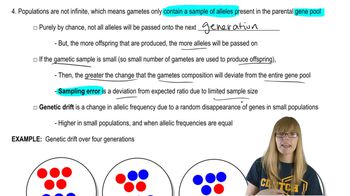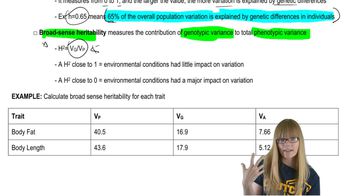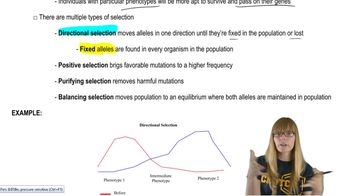Table of contents
- 1. Introduction to Genetics51m
- 2. Mendel's Laws of Inheritance3h 37m
- 3. Extensions to Mendelian Inheritance2h 41m
- 4. Genetic Mapping and Linkage2h 28m
- 5. Genetics of Bacteria and Viruses1h 21m
- 6. Chromosomal Variation1h 48m
- 7. DNA and Chromosome Structure56m
- 8. DNA Replication1h 10m
- 9. Mitosis and Meiosis1h 34m
- 10. Transcription1h 0m
- 11. Translation58m
- 12. Gene Regulation in Prokaryotes1h 19m
- 13. Gene Regulation in Eukaryotes44m
- 14. Genetic Control of Development44m
- 15. Genomes and Genomics1h 50m
- 16. Transposable Elements47m
- 17. Mutation, Repair, and Recombination1h 6m
- 18. Molecular Genetic Tools19m
- 19. Cancer Genetics29m
- 20. Quantitative Genetics1h 26m
- 21. Population Genetics50m
- 22. Evolutionary Genetics29m
21. Population Genetics
Allelic Frequency Changes
Problem 6
Textbook Question
Genetic drift, an evolutionary process affecting all populations, can have a significant effect in small populations, even though its effect is negligible in large populations. Explain why this is the case.
 Verified step by step guidance
Verified step by step guidance1
Genetic drift refers to random changes in allele frequencies within a population, which can lead to significant evolutionary changes over time.
In small populations, the impact of random events is more pronounced because each individual represents a larger fraction of the total gene pool.
For example, if a few individuals in a small population fail to reproduce due to random chance, their alleles may be lost from the population entirely, leading to a significant shift in allele frequencies.
In contrast, in large populations, the effect of random events is diluted because each individual represents a smaller fraction of the total gene pool, making it less likely for random events to significantly alter allele frequencies.
Therefore, genetic drift can lead to rapid changes in small populations, potentially resulting in the fixation or loss of alleles, while its effect is minimal in large populations where allele frequencies remain relatively stable.
Recommended similar problem, with video answer:
 Verified Solution
Verified SolutionThis video solution was recommended by our tutors as helpful for the problem above
Video duration:
2mPlay a video:
Was this helpful?
Key Concepts
Here are the essential concepts you must grasp in order to answer the question correctly.
Genetic Drift
Genetic drift is a mechanism of evolution that refers to random changes in allele frequencies within a population. It occurs due to chance events that can lead to the loss or fixation of alleles, particularly in small populations where random sampling errors can have a more pronounced effect. This randomness can result in significant evolutionary changes over time, even without natural selection.
Recommended video:
Guided course

Genetic Drift
Population Size and Its Impact
The size of a population plays a crucial role in the impact of genetic drift. In small populations, random events can drastically alter allele frequencies because each individual's genetic contribution represents a larger proportion of the total gene pool. Conversely, in large populations, the effects of random sampling are diluted, making it less likely for genetic drift to significantly influence allele frequencies.
Recommended video:
Guided course

Calculating Heritability
Fixation and Loss of Alleles
Fixation occurs when an allele reaches a frequency of 100% in a population, while loss refers to an allele disappearing entirely. In small populations, genetic drift can lead to rapid fixation or loss of alleles, reducing genetic diversity and potentially impacting the population's ability to adapt to environmental changes. This phenomenon highlights the vulnerability of small populations to evolutionary changes driven by random processes.
Recommended video:
Guided course

New Alleles and Migration

 5:58m
5:58mWatch next
Master Natural Selection with a bite sized video explanation from Kylia Goodner
Start learning


